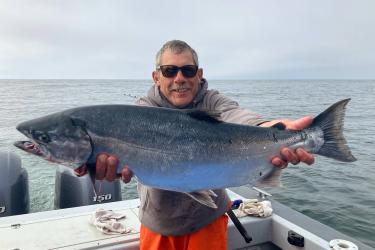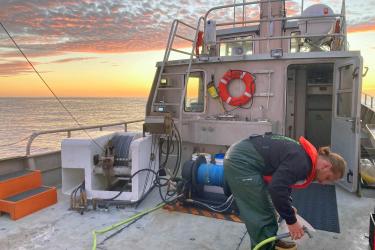Microbiomes are the communities of microscopic organisms that live with animals such as fish or in the environment. Although bacteria, fungi, and viruses are the most commonly recognized members of microbiomes, phytoplankton and protists are also abundant in environmental microbiomes.
Microbiomes in fish typically live on surfaces such as skin, gastrointestinal tract lining, and respiratory organs (e.g., gills, trachea). The overwhelming majority of these microbes co-exist with their hosts in a harmless or mutually beneficial relationship. The microbiome is often essential for the animal's health. It produces necessary vitamins, prevents colonization by pathogenic microbes, and stimulates appropriate immune responses. Although most microbial research has focused on disease-causing microorganisms, we now are directing more attention to understanding microbiome contribution to animal health.
Environmental microbiomes occur in every habitat and ecosystem niche, and represent the interface between the physical and chemical environment with the biological sphere. These microorganisms recycle organic material and dissolved nutrients and synthesize biomass that forms the base of the food web. Both heterotrophic (e.g., most bacteria) and autotrophic (e.g., phytoplankton) microbes are primary producers that provide food to larger organisms such as protists, zooplankton, and larval fish.
Research
- Apply microbiome research in health assessments of protected species.
- Develop microbiome tools for evaluating freshwater and marine environments.
- Explore the utility of microbiome analysis for aquaculture technology.
Specific research includes:
- Microbiomes of Southern Resident killer whales (gut, mucus, breath).
- Microbiomes response to urban stream restoration.
- Application of microbiome research in sablefish aquaculture.
Collaborators
- Cascadia Research Collective (Olympia, WA, USA)
-
Fisheries and Ocean Canada (Pacific Enterprise Science Centre, West Vancouver, BC, Canada)
- Seattle Public Utilities (Seattle, WA, USA)
- Stanford University School of Medicine (Stanford, CA, USA)
- University of Illinois at Chicago (Chicago, IL, USA)
Publications
Dodd, E.T., M.L. Pierce, J.S.F. Lee, R.S. Poretsky. 2020 (In press). Influences of claywater and greenwater on the skin microbiome of cultured larval sablefish. Animal Microbiome
Raverty, S. A., L. D. Rhodes, E. Zabek, A. Eshghi, C. E. Cameron, M. B. Hanson, J. P. Schroeder. 2017. Respiratory Microbiome of Endangered Southern Resident Killer Whales and Microbiota of Surrounding Sea Surface Microlayer in the Eastern North Pacific. Scientific Reports, 7(394):1-12. doi:10.1038/s41598-017-00457-5
Rhodes, L. D., R. B. Johnson, M. S. Myers. 2016. Effects of plant-based lipid feeds on hepatic and gastrointestinal histology and the gastrointestinal microbiome of sablefish (Anoplopoma fimbria). Aquaculture, 464:683-691. doi:http://dx.doi.org/10.1016/j.aquaculture.2016.05.010
Oyafuso, Z., A. E. Baxter, J. E. Hall, S. M. Naman, C. M. Greene, L. D. Rhodes. 2015. Widespread detection of human- and ruminant origin Bacteroidales markers in subtidal waters of the Salish Sea in Washington State. Journal of Water and Health, 13(3):827-837.
Contact
Linda D. Rhodes, Marine Microbes and Toxins Program Manager



